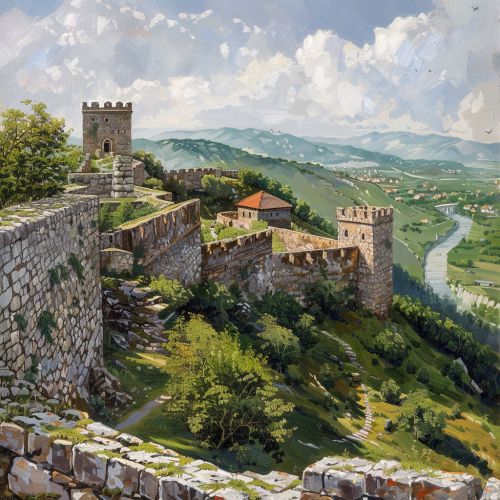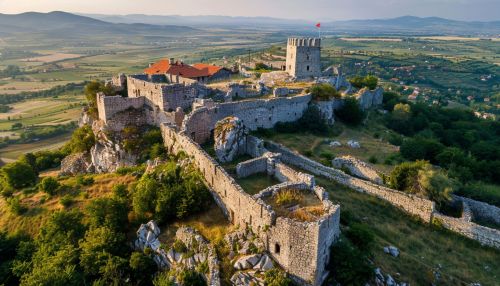Serbian Empire: Difference between revisions
(Created page with "== History of the Serbian Empire == The Serbian Empire, a medieval state that existed from 1346 to 1371, was a significant political entity in Southeast Europe. It emerged from the Kingdom of Serbia and reached its zenith under the rule of Emperor Stefan Dušan the Mighty. The empire's establishment marked a period of territorial expansion, cultural development, and legal reform. === Foundation and Expansion === The Serbian Empire was officially proc...") |
No edit summary |
||
| Line 7: | Line 7: | ||
The Serbian Empire was officially proclaimed on April 16, 1346, when King Stefan Dušan was crowned Emperor in Skopje. This event followed a series of military successes that expanded Serbian territories to include parts of modern-day Albania, Greece, Montenegro, and North Macedonia. Dušan's ambition was to create a powerful state that could rival the Byzantine Empire, which was then in decline. | The Serbian Empire was officially proclaimed on April 16, 1346, when King Stefan Dušan was crowned Emperor in Skopje. This event followed a series of military successes that expanded Serbian territories to include parts of modern-day Albania, Greece, Montenegro, and North Macedonia. Dušan's ambition was to create a powerful state that could rival the Byzantine Empire, which was then in decline. | ||
[[Image:Detail-95171.jpg|thumb|center|Medieval Serbian fortress with surrounding landscape.|class=only_on_mobile]] | |||
[[Image:Detail-95172.jpg|thumb|center|Medieval Serbian fortress with surrounding landscape.|class=only_on_desktop]] | |||
Dušan's military campaigns were characterized by strategic alliances and decisive battles. Notably, the Battle of Velbazhd in 1330 against the Bulgarians solidified Serbian dominance in the region. By 1345, Dušan had conquered significant Byzantine territories, including Epirus, Thessaly, and parts of Macedonia. | Dušan's military campaigns were characterized by strategic alliances and decisive battles. Notably, the Battle of Velbazhd in 1330 against the Bulgarians solidified Serbian dominance in the region. By 1345, Dušan had conquered significant Byzantine territories, including Epirus, Thessaly, and parts of Macedonia. | ||
Latest revision as of 14:00, 4 July 2024
History of the Serbian Empire
The Serbian Empire, a medieval state that existed from 1346 to 1371, was a significant political entity in Southeast Europe. It emerged from the Kingdom of Serbia and reached its zenith under the rule of Emperor Stefan Dušan the Mighty. The empire's establishment marked a period of territorial expansion, cultural development, and legal reform.
Foundation and Expansion
The Serbian Empire was officially proclaimed on April 16, 1346, when King Stefan Dušan was crowned Emperor in Skopje. This event followed a series of military successes that expanded Serbian territories to include parts of modern-day Albania, Greece, Montenegro, and North Macedonia. Dušan's ambition was to create a powerful state that could rival the Byzantine Empire, which was then in decline.


Dušan's military campaigns were characterized by strategic alliances and decisive battles. Notably, the Battle of Velbazhd in 1330 against the Bulgarians solidified Serbian dominance in the region. By 1345, Dušan had conquered significant Byzantine territories, including Epirus, Thessaly, and parts of Macedonia.
Governance and Legal Reforms
One of the hallmarks of Dušan's reign was the codification of laws, known as Dušan's Code. This legal document, enacted in 1349 and expanded in 1354, was one of the most comprehensive medieval law codes. It addressed various aspects of governance, including the administration of justice, property rights, and the responsibilities of the nobility.
Dušan's Code was instrumental in centralizing the administration of the empire and reducing the power of local nobility. It also sought to protect the rights of peasants and ensure fair treatment under the law. The code's influence extended beyond the Serbian Empire, impacting legal systems in the Balkans for centuries.
Cultural and Religious Influence
The Serbian Empire was a center of cultural and religious activity. The Serbian Orthodox Church played a crucial role in unifying the empire and promoting Serbian identity. In 1346, the church was elevated to the status of a patriarchate, with the Archbishop of Peć becoming the first Serbian Patriarch.
Monasticism flourished during this period, with numerous monasteries being built or expanded. The Monastery of Visoki Dečani, constructed between 1327 and 1335, is a prime example of the architectural and artistic achievements of the time. These monasteries were not only religious centers but also hubs of education and manuscript production.
Decline and Fall
The decline of the Serbian Empire began with the death of Stefan Dušan in 1355. His son, Stefan Uroš V, known as Uroš the Weak, lacked the political acumen and military prowess of his father. The empire faced internal strife and external threats, particularly from the advancing Ottoman Empire.
By 1371, the Battle of Maritsa marked a significant defeat for the Serbian forces, leading to the fragmentation of the empire. The death of Uroš V later that year without an heir resulted in the disintegration of centralized authority. The once-mighty Serbian Empire was divided among regional lords, paving the way for Ottoman domination in the Balkans.
Economy and Society
Economic Structure
The economy of the Serbian Empire was predominantly agrarian, with agriculture being the mainstay of the population. The fertile plains of the Morava and Vardar valleys were particularly important for grain production. Livestock farming, including sheep and cattle, was also significant.
Trade played a crucial role in the empire's economy. The strategic location of the Serbian Empire along important trade routes facilitated commerce with neighboring states and distant regions. Key trading partners included the Republic of Venice, the Republic of Ragusa, and various Byzantine cities. The export of silver, copper, and other minerals from Serbian mines was particularly lucrative.
Social Hierarchy
The social structure of the Serbian Empire was hierarchical, with the emperor at the apex, followed by the nobility, clergy, and peasantry. The nobility, known as Vlastela, held significant power and land. They were responsible for providing military support to the emperor and administering their estates.
The clergy, particularly the higher echelons of the Serbian Orthodox Church, wielded considerable influence. Monasteries owned vast tracts of land and were involved in various economic activities, including agriculture and artisanal production.
Peasants, who formed the majority of the population, were primarily engaged in farming. They were subject to various obligations, including paying taxes and providing labor services to their lords. Despite these burdens, Dušan's Code sought to protect their rights and ensure fair treatment.
Military Organization
The military organization of the Serbian Empire was a key factor in its expansion and defense. The army was composed of various units, including heavy cavalry, infantry, and mercenaries. The Pronija system, similar to the Byzantine Pronoia, was used to grant land to soldiers in exchange for military service.
Heavy cavalry, known as Kataphraktoi, formed the backbone of the Serbian army. These heavily armored knights were crucial in battles and were often drawn from the nobility. Infantry units, including archers and spearmen, provided support and versatility on the battlefield.
Mercenaries, both local and foreign, were employed to bolster the ranks of the army. These professional soldiers brought diverse skills and experience, enhancing the military capabilities of the empire.
Legacy
The legacy of the Serbian Empire is multifaceted, encompassing legal, cultural, and historical dimensions. Dušan's Code remains a significant legal document, reflecting the complexities of medieval governance and justice. The architectural and artistic achievements of the period, particularly in monastic construction, continue to be celebrated.
The Serbian Empire's role in shaping the history of the Balkans is undeniable. Its interactions with neighboring states, both through conflict and diplomacy, influenced the political landscape of Southeast Europe. The empire's eventual fall and the subsequent Ottoman conquest marked a turning point in the region's history.
